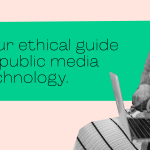
WGBH Case Study One
Interview with Shane Miner
February 2020
WGBH is a public media organization based in Boston, the largest producer of content for PBS, and a member of National Public Radio (NPR). It’s output not only includes radio broadcast, but podcasts, apps, television and events. It prioritizes content and journalism that serves the public interest and seeks to broaden knowledge across news, education, science, history and culture. It was a co-producer of the Bafta award-winning and Oscar-nominated documentary ‘For Sama’ in 2019, and has won numerous other awards for its journalism. Shane Miner is their Chief Technology Officer.
What was the last major tech decision, or tech strategy decision, that you had to make in your particular job at WGBH?
We’re just finishing a migration from Box to Google Drive. We’re moving our phones from 8×8 to Zoom for both web conferencing and telephone. We’re a big office of 365 subscribers for mail primarily, but also SharePoint, One Drive, and Skype for business teams. We’re Slack users and prior to this used HipChat before it was discontinued; and we’re big Atlassian users, so Jira and Confluence.
How are your editorial and production teams involved in decisions about productivity software?
It’s a process. We do a pretty significant security review of products before we onboard anything – we have a whole series of security requirements that we’d expect a vendor to have. We’ll occasionally make an exception to some of them but for the most part we don’t want to work with anybody where security isn’t a significant component. This has been a major driver over the past five years.
Was there a particular trigger for this?
The first was Sony’s major incident that really brought to light that media and security mattered. And we happened to be starting a partnership with Sony providing a joint service. It was a cloud-based service and Sony’s breach of course then became news. The end result was positive for us in that their cloud products weren’t breached; and Sony made a big move to get more things into the cloud, so these products were buttoned up from a security perspective. They were built in a world where security mattered.
The other major event was KQED, the San Francisco NPR station, suffered a very serious ransomware incident that they’ve been very public about, they’ve shared a lot of information. To see that ransomware wasn’t going to avoid us just because we’re public media was a really big deal. So all of a sudden everyone wants to send a security survey before doing business with you. This sensitized us to what everyone else in the industry was expecting.
We’re always working on our culture of security, and that’s a challenge, but also incredibly important given today’s threat landscape.
Have you made decisions not to take particular services or products because they don’t meet your standards?
I would say change management is the hardest part of my job, it’s what I spend most time on. The technology is easy, the change management is hard.
Absolutely. Our move to Google Drive now is specifically because they’ve made such a huge effort to be an enterprise product that three or four years ago, frankly just didn’t exist. Our move from Box was caused by a few drivers. Our contract was up so we were assessing if it was still the right tool. It worked better for some of our groups than others, and a major consideration was that our external collaborators tend not to use it. So we reevaluated and looked at Dropbox and Google Drive, and Google Drive had come light years ahead in terms of security. It was really impressive. They’d clearly made an investment here. So we went through our process, and now we’re just finishing the migration. It’s still a bit of a challenge because some of our PBS collaboration is built around Box, and we’re decreasing our security around the product, so we’re trying to find ways through here as we work together a lot. And inevitably there were people here who loved Box, it was the best tool for them, and they didn’t want to move, so this was hard. There are about 800-900 who work here at WGBH, so there will always be different preferences. I would say change management is the hardest part of my job, it’s what I spend most time on. The technology is easy, the change management is hard.
How does WGBH feel about the major tech platforms generally? Could you imagine moving more broadly onto G Suite given your move to Google Drive?
I think we would struggle, as we have a lot of users who are very attached to Outlook. We have some requirements around data retention that make Google a little harder on the email side, whereas Microsoft has been shining for years in the way they let us control and manage this. We’re exceptionally Word, Powerpoint, etc dependent, so we’ll always use Microsoft Office to some degree. Our legal team lives in Word and wouldn’t collaboratively edit – they have to have more robust tools for data retention and discovery, so there isn’t a compelling reason for them to change. But this might not be true in five years, so we’ll keep evaluating.
What kind of strategic issues are you facing on production and distribution technologies?
For production, it’s about how we can work anywhere anytime. Right now, we’re a pretty Avid heavy shop, although we do have a bunch of Premiere tools and Audacity and Audition for audio. Audio tools tend to be a little more mobile, because of the nature of their file sizes. But video tools are bound to the large amount of internal storage they require.
We’re pretty heavy cloud consumers both from a SAAS product and infrastructure perspective. So there is a really compelling case for us to look at how we can secure a portion of the cloud to do more video production – what could this look like, and how do we get there? We’re working with our Archive and Production teams to change the way we store media that isn’t currently in production. We’ll keep a first copy on storage in the building, and a second copy direct to Glacier and see what this looks like for an offsite store. As with many public media archives, there are a ton of non-digital assets – although our team has made great headway with grants to digitize large sections of older content.
We think there is a huge opportunity to leverage cloud storage. If you had an open source project or a low cost product that leveraged S3 as the place that it looked to, anybody can bring the project or product up at any time.
I’ve said for a long time that all you need is a MAM (Media Asset Management system) that does four things: upload, download, search and preview. That’s it. It only has to do four things really well. All of our storage built internally is on object store, the same storage as Amazon S3. We think there is a huge opportunity to leverage cloud storage. If you had an open source project or a low cost product that leveraged S3 as the place that it looked to, anybody can bring the project or product up at any time. So there’s scalability, you just have to figure out how to get it onto Glacier or tell people to set up an object store locally. And in our world now we have a great disaster recovery plan, which is we take our software, point it at Amazon instead of pointing it internally, and we can access all our media and keep working. Though the cost of this is a consideration. We’ll see how it goes over time, but we may have to adjust based on the operating costs.
Are there other kinds of strategic or ethical issues about the dominance of people like Amazon, particularly in storage?
We try very hard to not be completely vendor dependent. It’s hard, but it’s just part of the business of technology – you build the plan when you go into something but you have to be ready to leave it.
I would say this comes up more for us around security and sometimes ownership. So when we vet a security firm or when we’re doing security monitoring around our journalists, we look at who owns this company, and where they come from in the world. I think it’s a challenge for everybody working in public media and tech. We want to be able to move whenever we feel like it, so we try to build this into our plan. We try very hard to not be completely vendor dependent. It’s hard, but it’s just part of the business of technology – you build the plan when you go into something but you have to be ready to leave it.
What are the other drivers behind your main technology decisions? Are there drivers that come from the editorial side of your organization?
We knew five years ago that we’d want to live in a world where we could have all remote workers, or be working all over the world at any one time. And we wanted to be more cloud based because we felt like this was going to be an economic driver for us. But it also felt like it would be a fairer place, and enable better collaboration.
We knew what our infrastructure was, but we couldn’t go straight from A to Z. It was going to be a process. So for the first two or three years, we just focussed on infrastructure – internal, internet connectivity, VPN connectivity. We could only handle about 100 concurrent VPN users five years ago and of course this wasn’t going to be acceptable going forward given we have close to 900 staff. Then we started to look at delivery and sharing tools, and now most of the tools are in regular review as opposed to constantly adding many more, which is a lighter process.
Next up is workflow efficiency. The process of delivering media here is not as effective as it could be. The digital world and the broadcast world tend not to run down the same paths, so it takes more staff and more product to do both. We’ve started to bridge these gaps. We’ve built a bunch of automation and API control to allow the media that we deliver to our broadcast facility to be scheduled to deliver to our digital outlets. Now it’s the process of teaching the folks who do this work how to use it. It’s a meaningful workflow impact – all of a sudden instead of six people touching the media, we’re down to one or two.
We’re also constantly looking at how to standardize our work and workflows. There are so many efficiency gains to be had just by doing a deep dive into how things happen at a station.
We’re also constantly looking at how to standardize our work and workflows. There are so many efficiency gains to be had just by doing a deep dive into how things happen at a station. That’s been true for me at previous stations too. It is really common for someone’s work around to become the standard, even if it’s not the most efficient.
Shane Miner
Chief Technology Officer at WGBH

